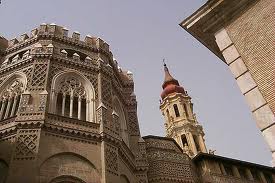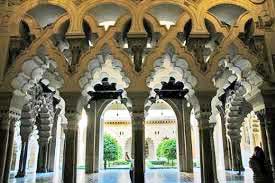
Muslims left their mark on many cities in this country, and Zaragoza is certainly no exception. In fact, one of the best examples of Muslim architecture in Spain can be found right here in the magnificent Aljaferia. It was built in the 11th century as a home for King Abu Jafar Moctadir, and was later used as a palace and court by almost all the subsequent royals. Located on the banks of the River Ebro, it is outstanding in size and beauty.
After the re-conquest of Spain by the Christians, an unusual thing happened in Zaragoza. Muslims were allowed to stay and even to keep their own laws, customs and religion. Their unique and highly decorative style of architecture and design was given the name "Mudejar", which was allowed to flourish under the atmosphere of cultural tolerance. The Islamic traditions and Christian styles were combined to build and decorate many buildings. Inexpensive materials like brick, plaster, wood, and ceramic tiles were used to beautifully adorn apses, towers and churches with intricate geometrical shapes, archways and ornate bands of stone lace work.
There are many outstanding examples of Mudejar architecture in Zaragoza and Aragon, many of which have earned UNESCO World Heritage status. Here's a list of some of the best:

Cathedral of San Salvador o La Seo
Plaza de la Seo
Church of San Pablo
San Pablo Street, 42
Church of Santa Maria Magdalena
Magdalena Square
Convento del Santo Sepulcro
Don Teobaldo, s/n
House and arch of the Dean
Dean Street, 5
Iglesia Parroquial de San Gil Abad
Don. Jaime I street, 15
Iglesia Parroquial de San Miguel de los Navarros
San Miguel, 52
Palace of the Aljafería.
Avenida de Madrid, Aljaferia Park
Torreón de Fortea
Torrenueva, 25
Tower of Zuda
Pio XII Small Square